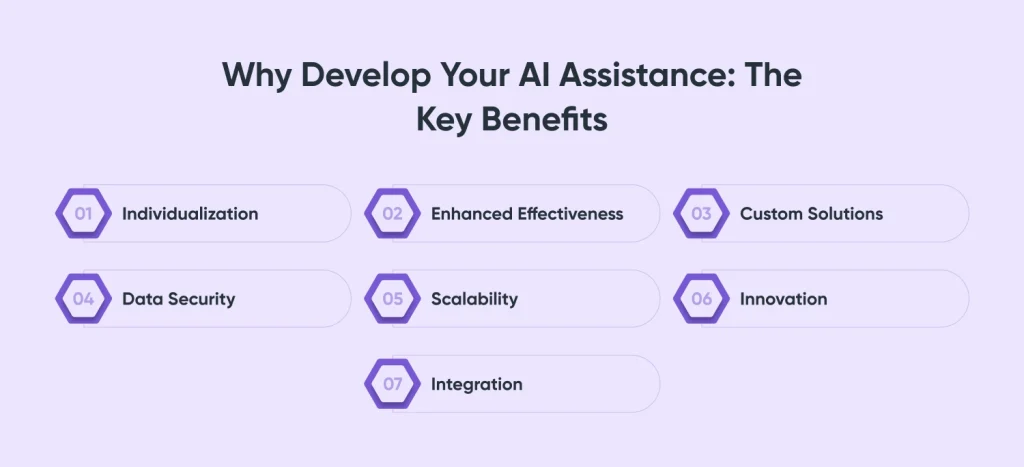As per ScienceDirect, the size of the AI market is predicted to reach $267 billion in the next five years with Gen AI playing a major role.
We now have our virtual pals, companions, and helpers, just as in science fiction films. It used to be impossible to achieve this. But this is true given the current global tech boom and significant technological developments. Individuals can simply ask their phones to arrange a meeting at a particular time and place, and the phones will oblige. It’s more of an app for virtual help than a phone. Now, all you have to do is ask Alexa to play Radiohead, and the music will start playing right away.
Apps for virtual assistance make it easy to do all of this and more. In this blog, we’ll delve deeply into this complex app category. We’ll also walk you through the easy process to create your own AI assistant.
What is AI Digital Assistant and Its Types?
For any business to use AI, a top-notch AI assistant known as Gen AI is taken as a creative collaboration. Machine learning algorithms behind it are capable of creating unique content and carrying on authentic, human-like interactions. It improves product quality and expedites feature rollout, which makes it ideal for the banking, real estate, healthcare, and social sectors.
AI assistants come into one of several main groups based on their primary purpose:
- AI assistants known as chatbots communicate with users via chat interfaces. They are often used in customer service, providing assistance with various operations, and responding to commonly requested queries.
- Today, Siri, Alexa, and Google Assistant work with the help of voice commands that is integrated with several functions and features such as providing weather conditions, playing music, smart home systems, reminders, etc.
- Specialized virtual assistants are made to help with particular jobs or industries. For example, a virtual assistant in the banking industry can help manage investment portfolios, while one in the healthcare industry can help with medical diagnosis. These aides are tailored to provide knowledge in particular fields.
Different kinds of AI assistants are made to fit different scenarios and user interactions, and they are intended for certain tasks.
Why Develop Your AI Assistance: The Key Benefits

Developing your own AI is a good endeavor because it has many benefits. We’ll go over the many advantages of creating your own AI assistant in this section, along with the compelling reasons to get started.
Individualization
One incredible benefit of building your own AI helper is personalization. Your assistant can be tailored to your requirements, preferences, and tasks, unlike generic AI solutions. It will get to know your daily habits and specific needs to provide you with a personalized experience that greatly improves your everyday life and productivity.
Enhanced Effectiveness
You may effortlessly manage your schedule, automate tedious jobs, create reminders, and carry out a variety of other tasks by building your own AI assistant. Your time and attention can be better spent on more significant projects thanks to this increased efficiency.
Custom Solutions
Your needs might not be entirely satisfied by off-the-shelf AI helpers. You can customize its features to meet your unique requirements when you make a custom one. Your AI personalized assistant has the answers you need, whether it’s for controlling your smart home, automating work-related chores, or supporting your research.
Data Security
You may have total control over your data when you build your own AI assistant. Self-made assistants can be customized to prioritize data privacy and security, giving you peace of mind, in contrast to commercial AI solutions that may collect and profit from your personal information.
Scalability
You have the freedom to grow and improve your AI helper as your needs change. Its capabilities will be increased, new features will be added, and it will be seamlessly integrated with other devices and services. Being in charge of its creation offers countless customization options.
Innovation
By creating your AI-powered assistant, you let creativity and discovery flow freely. It gives you and your team access to cutting-edge technologies like chatbot development and voice recognition, opening up new avenues for both professional and personal development.
Integration
It’s simple to combine different apps and services when your AI assistant acts as a central hub. Your digital life is streamlined by this convenient connection, which provides a single point of contact for various tasks like email management and controlling smart devices.

The Best Tech Stack for Personal Assistant AI App- Points to Consider
A complete tech stack is essential to building a strong AI helper. This tutorial provides a thoughtful overview of the essential platforms and technologies needed to create an effective AI virtual assistant. Discover how to properly manage this challenging trip.
Select the Appropriate Cloud Platform
The features and cost of a cloud platform determine which one is best. Make sure you’ve done your homework thoroughly before choosing one. Popular choices include IBM Cloud, Microsoft Azure, Google Cloud Platform, and AWS. Everyone has their own specialties and cost structures.
Accept Natural Language Processing
Choosing a natural language processing (NLP) technology is crucial since your AI assistant must be able to understand complicated sentences and correctly interpret customer requests. Prominent natural language processing (NLP) technologies, such as Microsoft Bot Framework, IBM Watson Assistant, Lex by Amazon, and Google Dialogflow, can give your AI assistant strong language comprehension capabilities.
Utilizing Key AI Software
The right AI software is needed for your AI helper to operate effectively. Even for those without much experience with coding, open-source machine learning frameworks like PyTorch, TensorFlow, and Scikit-learn are essential for making AI software development easier.
Considering Pre-Trained vs. Custom Models
Although customized models for AI assistants may appear attractive, they should be given greater importance. For the time being at least, most users choose pre-trained basic models for their bots because fine-tuning is both expensive and hard.
How to Build an AI Assistant Software – Steps to Follow
Throughout the process, we can provide insightful advice and industry best practices thanks to our extensive knowledge and experience at CMARIX. Discover a realistic and appealing roadmap for creating AI assistants for businesses, from use cases to the big launch.
Step 1: Identify the Main Use Cases for AI Assistant
Determining the essential use cases for your AI assistant requires a thorough understanding of your users and their unique requirements. For example, CMARIX’s Plai AI assistant can create new OKRs based on the specific needs and strategies of every business.
Step 2: Select the Best Technologies for Your AI Assistant
Making an effective AI assistant requires careful consideration of the technology stack. Selecting technologies based on their ability to meet your use cases would be beneficial. The efficiency and functionality of the AI assistant are built upon this phase.
Step 3: Handle Your AI Assistant’s Development
Choosing a foundation model, creating prompts, and incorporating AI history are all necessary steps in creating an AI assistant. To properly implement the assistant’s functionalities and answers, each step needs to be carefully considered.
Step 4: Choosing Your AI Assistant’s Base Model
Selecting the appropriate base model is essential. Your AI assistant’s basis and essential functions are determined by this model.
Step 5: Creating Prompts for Your AI Assistant
Your AI assistant’s interactions with users are guided by prompts. It’s important to anticipate potential questions or orders and comprehend the needs of your consumers while creating efficient prompts. Your AI assistant should be able to respond intelligently to these commands.
Step 6: Including Contextual and Historical Sources for AI
It is imperative to incorporate sources of AI history and context. These resources serve as the foundation for your AI assistant’s knowledge base, giving it important contextual knowledge. Providing precise and pertinent context sources improves the efficacy of your AI assistant’s responses.
Step 7: Creating Novel AI Functionalities
Creating new AI features enables your AI helper to provide something special. These characteristics ought to be customized for your good or service, making your AI assistance a powerful tool for addressing your user’s specific needs.
Step 8: Easily Include AI Assistant Into Your App or Product
To maximize user involvement, your product or app must include the AI assistant. Creating an easy-to-use interface improves the user experience by enabling consumers to communicate with the assistant quickly and effectively.
Step 9: Create an Interaction with the AI Model That Is User-Friendly
The user’s comfort level when interacting with an AI assistant is a major factor in its success. Your application or product should have an intuitive flow that provides direction and a clear context.
By giving the AI assistant example prompts, use cases, and an onboarding video, users may better comprehend and interact with the helper. It’s crucial to make sure users understand the model’s goal to prevent misuse and the disappointments that may follow, improving their overall satisfaction.
Step 10: Address AI Errors in the Design Process
A crucial step for AI in UX design process is preparing for AI errors. Giving users the ability to edit, review, regenerate, or update the output or response helps to control potential problems and ensures a better, more regulated user experience.
Step 11: Improve Your AI Assistant to Perfection
Once your AI helper is operational, the work is far from done. Maintaining the high performance and user happiness of the assistant requires constant debugging and fine-tuning. You can guarantee that your helper remains at the top of its game with regular updates and enhancements.
Step 12: Execute, Assess, and Iterate Your AI Assistant Plan
After your AI helper is launched, get user feedback so you can adjust and refine your approach. Utilize this knowledge to iterate and enhance your AI assistant leading to constant advancement.
Conclusion
Creating an AI assistant for website is a difficult but rewarding project.It allows you to explore the exciting field of artificial intelligence and empowers you to design a one-of-a-kind product that improves your life or could serve as the foundation for a fresh company concept. If you have a clear objective, select the appropriate technology stack, and exhibit unwavering persistence, you can create your own AI assistant from the ground up and see it grow into an invaluable, personalized resource.
Developing an AI assistant is challenging, and there may be obstacles in your path. However, you’ll be well on your way to developing your virtual assistant if you follow the advice in this blog. Thus, get ready to start making an AI with the best development company that offers lucrative mobile app development services.
Frequently Asked Questions
How Will the AI Assistant Integrate with the Existing Web/Mobile App?
How Will the AI Assistant Integrate with the Existing Web/Mobile App?
How to Make Your Own AI Assistant for Android?
Step 1: Identify the Goal of Your AI Assistant
Step 2: Selecting the Appropriate Technology Stack
Step 3: Preprocessing and Data Cleaning
Step 4: Gather and Prepare Data
Step 5: Training Your AI Assistant
Step 6: Create the User Interface
Step 7: Get Voice Recognition to Use
Step 8: Testing and Debugging
Step 9: Deployment
Step 10: Maintenance and Assistance
How Will the AI Assistant Handle Cross-Platform Compatibility?
AI and ML eliminate human error from the equation, speeding up and improving the reliability of testing procedures. AI is capable of creating and executing test scripts, enhancing test analysis, and doing regular checks. In the meantime, machine learning can benefit businesses through cost savings, error and improvement prediction, and the use of previous data.







